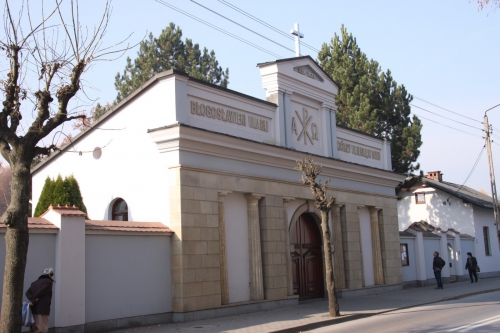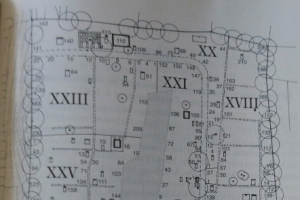Cemetery parish
Initially, the burial site was located in the immediate vicinity of the church, i.e. in the city center, constituting an epidemiological threat to the inhabitants. In 1784, Emperor Józef II issued a decree obligating the location of cemeteries outside the settlements, enclosing them with walls and the possibility of erecting residential buildings not closer than 5 fathoms (about 10 meters) from the burial sites. The church necropolis was moved to a new place at ul. Tatrzańska (formerly Nowotarska), therefore called "cemetery street", most probably in 1819 - after the establishment of the district headquarters in the city. One of the first buried in the cemetery was the parish host, builder of a stone church, Jan Kanty Krassowski, buried in November 1822. In subsequent years, the cemetery was expanded, including during the parish priest Alekse Bocheński (1849-1893). Today, the cemetery covers the area between the street of Our Lady of Fatima and Aleja Wolności (once customarily called "street above the cemetery") with an area of about 3 hectares.
The most characteristic place at the parish cemetery, which is entered through a classical gate, is the centrally located chapel of the Słap family, erected in 1862 and handed over to the parish after World War II. The chapel is the burial place of the members of the Słap family and Wadowice priests: priest. canon Tadeusz Włodyga (died 1963), priest Monsignor Leonard Prochownik (d. 1963) and priest Infułat Edward Zacher (died 1987). The cemetery includes a separate section for OO. Discalced Carmelites, mausoleum of SS. Nazareth and soldier's quarters. The most impressive tombs include graves of the Homme, Romaszkanów and Stankiewicz families. Some of the tombstones are the work of Wadowice artists-sculptors: Franciszek Suknarowski, Józef Jura and Wincenty Bałys (tomb of the Homme).
Famous figures buried in the Wadowice parish cemetery:
Seweryn Artz (1842-1907), professor and director of junior high school,
Juliusz Bijak (1860-1943), commander of the spare personnel of the 56th Infantry Regiment, general of the Polish Army,
Ignacy Brosig (1816-1889), mayor of Wadowice,
Jan Tytus Dihm (1902-1965), doctor of philosophy, historian, associate professor of the Polish Academy of Sciences,
Karol Trzaska-Durski (1849-1935), weapons general of the Polish Army,
Jan Dworak (1858-1931), mayor of Wadowice,
Foltynowie (Foltinowie), a family of Wadowice printers, owners of the publishing house and bookstore,
Kazimierz Foryś (1906-1982), junior high school professor, director of high schools in Andrychów and Wadowice,
Mieczysław Władysław Gedl (1852-1901), doctor, activist of the "Sokół" Gymnastic Society,
Jan Iwański (1849-1907), mayor of Wadowice,
Stefan Kotlarczyk (1874-1931), founder of the W. Jagiełło ("Jagiellonka"),
Józef Loserth (around 1793-1878), staroste of the Wadowice region,
Franciszek Opydo (1856-1923), member of the Vienna State Council, mayor and honorary citizen of Wadowice,
Czesław Antoni Panczakiewicz (1901-1958), junior high school professor, sports and tourist activist,
Józef Raczyński (around 1816-1881), a merchant, owner of Zawadka, the mayor of Wadowice,
Feliks Romaszkan (1857-1932), industrialist, owner of the paper mill in Wadowice,
Jędrzej Wowro (1864-1937), folk saint,
Tytus Zegadłowicz (182-1899), junior high school professor, father of Emil Zegadłowicz.


